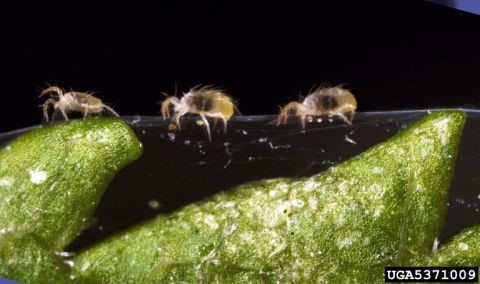ILSOYADVISOR POST
Are Spider Mites Our Next 2019 Challenge?
Because of the dry weather pattern we are in, there has been some conversation across the countryside about two-spotted spider mites becoming our next challenge in this crazy 2019 growing season.
 Before we dive too far into this discussion, let’s spend a minute understanding this pest. Two-spotted spider mites don’t just “appear” in hot, dry weather. There are always some spider mites in the environment, however, under our normal weather conditions the population of spider mites is kept in check by natural enemies that are either pathogens, insects or other mites. To the right is an image of spider mites on soybean leaves (Courtesy of the University of Minnesota Extension)
Before we dive too far into this discussion, let’s spend a minute understanding this pest. Two-spotted spider mites don’t just “appear” in hot, dry weather. There are always some spider mites in the environment, however, under our normal weather conditions the population of spider mites is kept in check by natural enemies that are either pathogens, insects or other mites. To the right is an image of spider mites on soybean leaves (Courtesy of the University of Minnesota Extension)
When the weather turns dry and hot, some of these natural predator populations can be reduced, thereby allowing the two-spotted spider mite populations to explode. So, the question is, are we hot and dry enough to reduce these natural predators? I don’t think we are … yet. The cool nights we are having plus morning dew should be enough to maintain the natural enemy populations that keep the two-spotted spider mite populations at a manageable level. In fact, the weather app on my iPhone shows nighttime temps in the 60s for the next couple of weeks.
Will a fungicide application on my soybeans control the pathogens that keep two-spotted spider mite populations in check? This possibility has not been investigated very thoroughly in the past. Keep in mind that economic outbreaks of spider mites are rare, making them difficult pests to research. Because such a phenomenon has not been widely reported by the extension community, my current belief is that this will not be a problem. In fact, foliar protection (like Bayer’s Delaro® + Leverage® 360) provides stress relief that should be a positive thing for soybeans under dry weather stress.
Should I switch to an insecticide that controls mites? Because of what we have discussed above, I would NOT switch out of a product like Leverage 360 for a product that is labelled on spider mites like Lorsban® or dimethoate, unless you have found only spider mites in your field. Remember that the products labelled for spider mites do not provide the length of residual, OR MORE IMPORTANTLY the stress relief that a product like Leverage 360 will provide.
Even with all the discussion above, we need to be diligent in scouting for two-spotted spider mite. Look on the undersides of affected soybean plants and leaves for mites, eggs and webbing in the lower canopy. Mites are almost impossible to see with the naked eye, so doing a simple “paper test” is a quick and easy way to confirm their presence. Shaking the plant onto a white piece of paper should allow you to see the tiny orange- to yellow-colored mites slowly moving on the paper. Even though a comprehensive threshold has not been developed for two-spotted spider mites in soybeans, some extension sources suggest treating when 20 to 25% discoloration is noted before pod set, or 10 to 15% discoloration after pod set.
In summary, let’s keep an eye out for two-spotted spider mites, but conditions are not perfect for them to explode right now. I believe that the value of the stress relief and residual insect control provided by a complete foliar protection package far outweighs switching to Lorsban or dimethoate unless we have found a population of two-spotted spider mites in a field





Comments
Add new comment